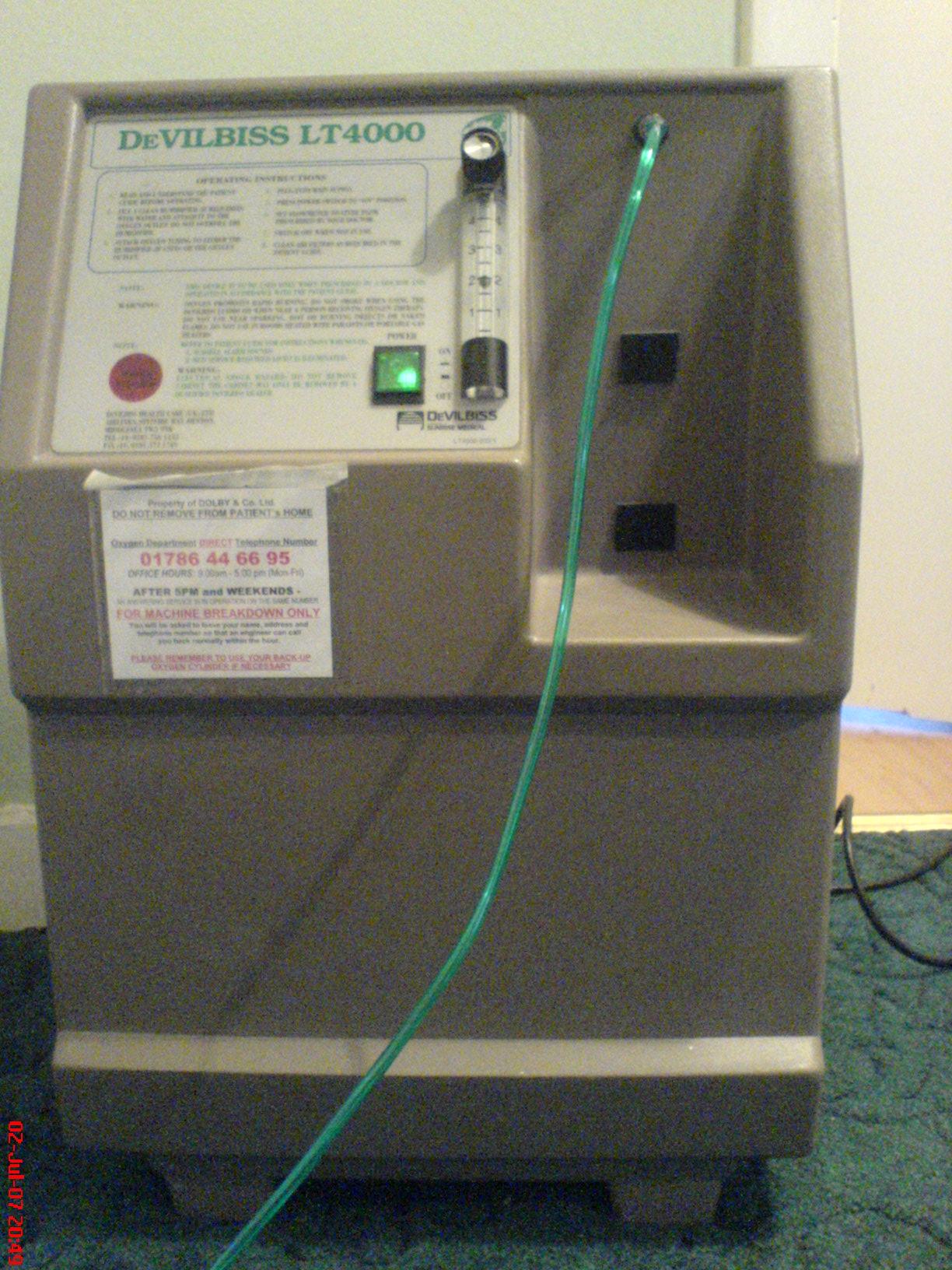Oxygen concentrator
Editor-In-Chief: C. Michael Gibson, M.S., M.D. [1]
Overview

An oxygen concentrator, also called an oxygen generator, is a device used to provide oxygen therapy to a patient at substantially higher concentrations than those of ambient air, used as an alternative to tanks of compressed oxygen. Oxygen concentrators are also used to provide an economical source of oxygen in industrial processes.
The simplest oxygen concentrator is capable of continuous delivery of oxygen and has internal functions based around two cylinders, filled with a zeolite material, which selectively adsorbs the nitrogen in the air. In each cycle, air is flowed through one cylinder at a pressure of around 20 lbf/in² (138 kPa, or 1.36 atmospheres) where the nitrogen molecules are captured by the zeolite, while the other cylinder is vented off to ambient atmospheric pressure allowing the captured nitrogen to dissipate. Typical units have cycles of around 20 seconds, and allow for a continuous supply of oxygen at a flow rate of up to approximately five liters per minute (LPM) at concentrations anywhere from 50 to 95 %. This process is called Pressure Swing Adsorption (PSA).[2] Since 1999, concentrators providing up to 10 LPM have been available for high flow patients, in sizes not much larger or heavier than 5 LPM concentrators. Industrial processes may use much higher pressures and flows. Another process has been developed by Air Products which they call Vacuum Swing Adsorption (VSA). It uses a single low pressure blower and a valve which reverses the flow through the blower so that the regeneration phase occurs under a vacuum. Generators using this process are being marketed to the aquaculture industry.[3] Pacific Consolidated Industries, LLC, [4] has taken VSA technology further to produce small, mobile or portable integrated units. Such systems eliminate the logistics of delivery and high transportation costs and make VSA-based concentrators ideal for governments and aid organizations in their emergency medicine and disaster relief operations, as well as for district hospitals in developing nations. Other commercial applications of oxygen concentrators include high-altitude work environments, such as in the mining industry or the Goldmud-Lhasa railroad in Tibet.
Since 2000, a number of manufacturers have introduced portable oxygen concentrators. Typically, these produce less than one liter per minute (LPM) of oxygen and use some version of pulse flow or demand flow to deliver oxygen only when the patient is inhaling. However, there is a portable oxygen concentrator with up to 3 LPM of continuous-flow oxygen, and this device also has pulse flow available to either provide higher flows or reduce power consumption. These portable concentrators typically plug into a wall outlet like the larger, heavier stationary concentrators. [5]
Portable oxygen concentrators usually can also be plugged into a vehicle DC adapter, and most have the ability to run from battery power as well for either ambulatory use, or use away from power, or airplane travel. The FAA has approved portable oxygen concentrators for use on commercial airlines, although it is necessary to check in advance if a particular brand or model is permitted on a particular airline.
Historically, demand or pulse flows have not been used for nocturnal use - sleeping - because if the nasal cannula moves and the concentrator is not able to detect when the patient is breathing in, it is not able to deliver the pulse while the patient is inhaling.
In both clinical and emergency care situations, oxygen concentrators have the advantage of not being as dangerous as oxygen cylinders, which can, if ruptured or leaking, explosively increase the combustion of a fire. As such, oxygen concentrators are particularly advantageous in military or disaster situations, where oxygen tanks may be dangerous or infeasible. Since oxygen concentrators are considered sufficiently non-volatile, they are leased to individual patients as a prescription item for use in their homes such as an adjunct to CPAP treatment of severe Sleep apnea.
These devices are currently in use by the US military in the conflicts in Iraq and Afghanistan, as part of the equipment complement of forward surgical teams.
Common models retail at around 800USD. Leasing arrangements may be available through various medical supply companies and/or insurance agencies.
Used, refurbished, and temperamental units are worthless to the medical community, as an individual's health frequently relies on the constant extended operation of the unit. Such units are however valuable to metal and glasswork hobbyists. Oxygen is one of the more expensive bottled gasses and medical oxygen concentrators or dedicated industrial (non-medical) oxygen concentrators can be made to operate a small oxy-acetylene torch quite easily, if only at small pressures.[6] Industrial oxygen concentrators are often available in a much wider range of capacities than medical concentrators and are sometimes referred to as oxygen generators within the oxygen and ozone industries to disambiguate from medical oxygen concentrators. The distinction is used in an attempt to clarify that industrial oxygen concentrators that are not FDA-approved medical devices are not suitable for use as bedside medical concentrators. However, applying the oxygen generator nomenclature can lead to confusion and is a misnomer in that oxygen is not generated as with a chemical oxygen generator, but is concentrated from the air. The use of the oxygen generator terminology can also be a problem for shipping logistics in the wake of the ValuJet Flight 592 crash. Note also that non-medical oxygen concentrators can be used as a feed gas to a medical oxygen system, like a hospital oxygen system, although FDA (or other region-specific regulatory, like CE) approval is required, additional filtration is generally required, and there may be other regulatory requirements as well.
Sources
- Casualties of War -- Military Care for the Wounded from Iraq and Afghanistan (New England Journal of Medicine)
- The Oxygen Concentrator